The re-appearance of lime as a building product during the last twenty or so years has clearly brought many advantages especially in the restoration of historical buildings. However, it has also raised a number of problems that we at Papers and Paints are consulted about on a daily basis. The most frequent question is – “What paint can I use on fresh lime plaster.”
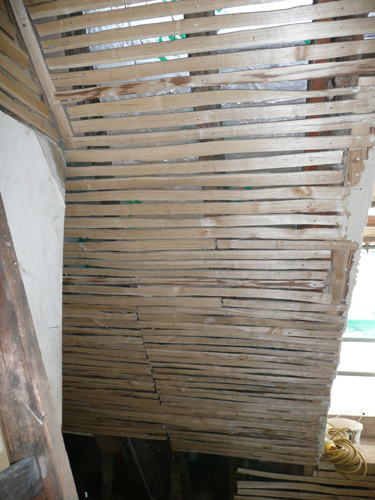
I see this blog as being a work in progress; one that I shall tweak and amend when the opportunity presents itself. Sitting, as I am on the sun-drenched terrace of a Portuguese villa, without access to my extensive library a few of my points could do with a little ‘firming up’. No matter. Having just received an email from an interior designer who now realises why I had been cautioning about the use of lime plaster and the problems of a short redecoration programme I feel that the time is right.
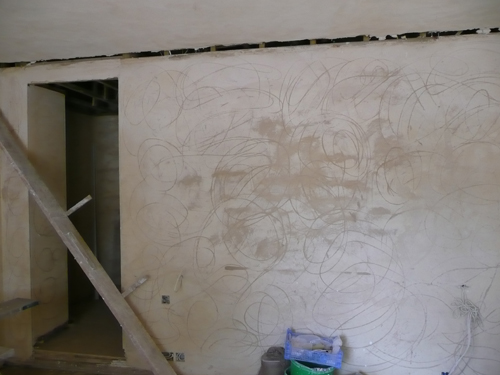
A difficulty with writing short pieces on complex subjects is that one must generalise and qualify all those statements for which an exception immediately springs to mind. Lime and its use in historical buildings is certainly one those subjects.
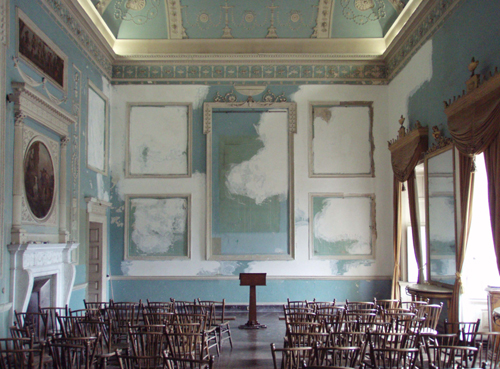
Many thanks to Richard Ireland
The use of lime in building, at least in the form of plaster, was the norm until the twentieth century. Thinking of our big cities alone, huge numbers of houses still retain lime-plastered walls under many layers of subsequent paint. Whilst one gives very little thought to the type of paint that is used on these it is certainly a consideration when it comes to the redecoration of newly refurbished historical buildings. For, although most plaster repairs carried out in the typical 1880s terraced house will be in the form of gypsum plaster, those buildings that have been the subject of extensive restoration – often with the involvement of outside agencies such as English Heritage – will almost invariably involve the use of new lime plaster.
When lime plaster was the norm it was well-understood that a period of time must elapse before walls could be decorated – or, at least, before anything other than a temporary coating could be applied. The main reason for this was the length of time that it took the water component to be released in the form of moisture vapour. This problem can better be appreciated if it is realised that a square yard of lime plaster contains nearly half a gallon of water in each coat. However, the sort of lime generally used in plastering hardens by a slow process of carbonation, reacting with carbon dioxide in the atmosphere over a period of time. Another possible problem is the high alkalinity of fresh lime. This diminishes with carbonation but must be considered especially if an oil-based paint is desired for the decoration.
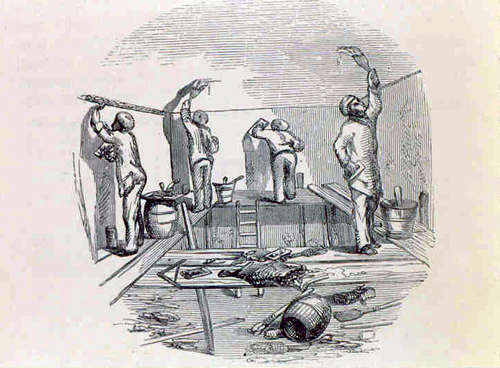
Peter Nicholson, in his An Architectural Dictionary, of 1819, spoke of (soft) distemper as a stop-gap measure:
“Painting in distemper, or water-colours mixed with size, stucco, or plaster, which is intended to be painted in oil when finished; but not being sufficiently dry to receive the oil, may have a coating in water-colours, of any given tint required, in order to give a more finished appearance to that part of the building”
He continued:
“It will not require less than two coats of any of the foregoing colours in order to cover the plaster, and bear out with an uniform appearance. It must be recollected, that when the stucco is sufficiently dry, and it is desirable to have it painted in oil, the whole of the water colour ought to be removed; which may be easily done by washing; and, when quite dry, proceed with it after the directions given in oil painting on stucco.”
Nicholson was also aware of the implications of this long drying-out time, and in a comment on speculative building said:
“Perhaps, in general cases, where persons are building on their own estate, or for themselves, two or three years are not too long to suffer the stucco to remain unpainted; though frequently, in speculative works, as many weeks are scarcely allowed.”
Dr Ian Bristow refers to the common practice, until quite recently, of decorating the plasterwork in newly finished interiors first in a porous water-based paint (soft distemper), pending final decoration in oil a year or two later. He cites the accounts for Henry Pelham’s house in Arlington Street, London, which show that the whole of the staircase had been painted in this way by January 1746 and was not decorated in oil until about two years later. While carrying out the paint analysis in a number of early nineteenth century houses I have invariably found evidence for an initial scheme of soft distemper under subsequent layers of oil paint. Thomas Cubitt, the builder, advised his clients to live “under builder’s finish” for two years to prevent expensive decoration from being spoiled.
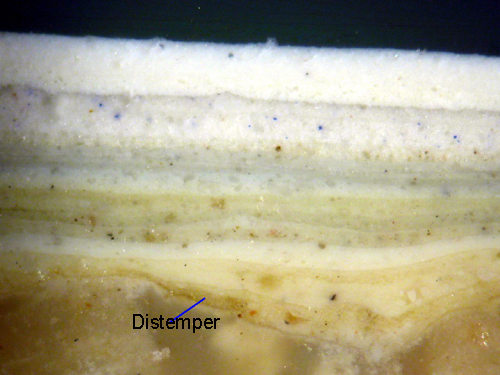
From the Library ceiling at Stowe
In a perfect world nothing would be applied to the walls for as long as a year, depending on the depth of plaster and the nature of the substrate. However that isn’t always practicable. The application of a true soft distemper is also not the most realistic option as it is fragile and the necessary skills to make it are rarely to be found.
Whatever you do, take care to avoid the so-called traditional paint route.
Richard Ireland, the expert on the conservation of decorative plaster has been faced with the subject of relevant paints many times, and he is one of the few specialists who have both the practical and theoretical knowledge to write on the matter.
He suggests that if early decoration is unavoidable there are two main options:
a) The first is the use of a ‘contract’ emulsion. These paints have the highest moisture vapour permeability rates of all emulsions and are specifically formulated for use on new plaster. Once the plaster is dry in depth more sophisticated emulsions can be used on top.
b) Another option might be Classidur Superclassic. This is a non-conventional solvent based system with properties that make it particularly suitable as a substitute for a soft distemper. These include high vapour permeability and a lack of surface tension.
In both instances there are limitations on the range of colours. Papers and Paints is one of the few specialists who are able to tint both these products.
Although not recommended for application to large areas, oil paints may be employed, but only once an alkali resistant primer has been applied.
Lime plaster is an excellent material in the restoration of historical buildings, but do remember that its use will require careful thought in terms of timing and its subsequent decoration.
View Larger Map


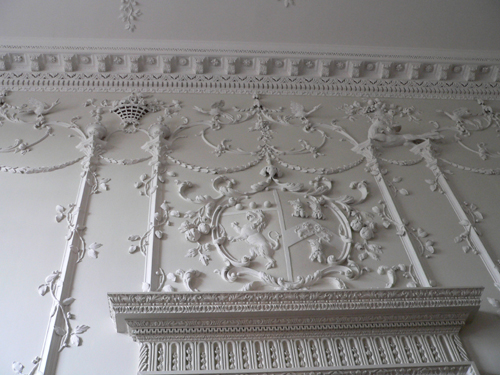










Patrick,
Thank you this information.
I’m wondering if you might have an idea of the likelihood
of lime being used in ‘interior hard-walling in 1935.
I recently bought a house in Booterstown, Dublin, and I’m not
sure what paint type to use, or does it matter?
Sorry for the boring question. I would appreciate your thoughts.
Thank you so much.
Bernard Smith
Thanks Bernard. I hope that you received my email response. Best wishes.
We had a grade 2 listed house newly lime plastered.
By how much would you water the miscoat down, paint is from Little green because it can breath.
Thank you.
Andrea Ashwell
I wasn’t aware that Little Greene had a breathable paint. If I were you I would use something like a thinned-down Dulux Trade Supermatt once the plaster is dry. You can always paint over that later when the plaster has cured.
I am an artist and I’m working on a project using some sort of plaster. I want to be able to apply the plaster to a wall and then write text into it before it sets up. I imagine using a sharp object to to etch into almost set plaster. Any advice?
Thank you Teresa. I’m afraid that this is not my area. It sounds rather like ‘Sgraffito’. Maybe you could learn something by following that up.
Patrick,
I am in a similar position to Bernard Smith above. I have recently purchased an older (1917) property and I am looking for a little advice on the correct paints/primers to use on the original plaster walls.
If you have on tips on the repair of small cracks that would also be very useful.
Also – apologies for the boring question! Unfortunately the work is not as ornate as the other projects on this site.
Thank you
Harris
Thank you. Plaster of that age is most unlikely to be reactive as it will have carbonated fully by now. I should treat it like my own (1883) house using good quality conventional paints and fillers. If you did want to apply an oil-based paint to the walls it might be as well to use an alkali-resisting primer, but I doubt if you will need it.
We are just getting our 200yr old farmhouse lime/hemp plastered and I was planning to paint with Earthborn claypaint after 5 weeks drying time. I believe we need a fully breathable paint. I called Earthborn who suggested a 4- 8 week drying time before painting.
Is this a good product for this? We don’t want any off gassing either.
I would hate to spend a load of money on this paint for it to blister or flake off! Any advice would be great.
Thanks
Dear Patrick
Your piece on decorating onto fresh lime summarizes and explains the issues very well, as does Richard’s to which you link. Thank you! Neither of you mention wallpaper, however.
With the growing tendency to specify lime in heritage projects, we now regularly receive inquiries from anxious paperhangers who have to install our products on fresh lime. I was wondering if you have any advice on this particular question?
Most of our papers are grounded/printed using acrylic paints (relatively impermeable I suspect), and I am wondering if the moisture given off by the lime as it cures will be sufficient to build up behind the paper, soften the paste and reduce adhesion? This hasn’t happened yet to my knowledge, but there is always a first time. Should we perhaps instead use what you and Richard call ‘contract’ emulsions where fresh lime is involved? And can these be pigmented in the strong, dark colours that our customers seem to like?
There is real need for those who draw up specifications to address these issues, rather than blithely stipulating lime and a tight deadline in the same breath.
Any thoughts very gratefully received,
David Skinner
We have a newly repaired ceiling using lime & horsehair plaster but the finish isn’t good enough just to paint, we need to paper it.
Can you advise what product should be used to adhere the paper and also what type of paint we can apply over the paper?
Thank you
Jane Palmer
The key thing is to wait until the plaster has dried in depth. You should then be able to hang lining paper with conventional wallpaper adhesive and to paint it with an emulsion paint.
Hi Patrick
Thanks for your article. Very very interesting.
I wonder if you can help me with a scenario I am trying to resolve. We have a vaulted lath and plaster ceiling where a section has collapsed. It’s hard to see why at a glance. However the whole thing has been decorated with a ‘wall glaze’ type (non-breathable) product sometime in the 90′s. There is good ventilation to the rear of the laths and the roof is uninsulated. The room is space heated but relatively mildly.
My instinct is the paint is the cause as it is stopping the plaster (which in itself looks fine, hair, lime etc) ‘breathing’ and thus causing a weak spot at the joint between ‘snot’ and main body of plaster. The ‘snots’ were left between the lathes when it came down.
Can you put any science to my instinct that simply by stopping the breathing process (in this instance without any real risk of condensation – as this would be room facing on the paint face) would weaken the plaster enough for it to sheer like this?
Any opinions much appreciated
Oliver
Dear Patrick – thank you for this article. We are refurbishing our detached 1899 solid granite, rendered house, patching and replastering some rooms with gypsum plaster. However, most walls are still covered in lime plaster. We had early advice that we would need to use lime paints but our decorator is planning on using a normal primer and then painting throughout with emulsion. Given that the exterior is rendered with a cement-based render from years ago, we assume that the breathability of the house is compromised anyway. We have done extensive building repair work to bay windows etc, and the property is now considered ‘dry’ by the builders. Should we proceed with the decorator’s plan? Your advice gratefully received, J
Hello,
We’re a very, very old paint manufacturing company based in Leeds. We’re about to start work on the renovation (supplying paints and coatings) of the interior of an old building (built 1697) which is lime plastered.
We make distemper (starch based) but I’ll probably look at a modern paint based on a polymer that is permeable to moisture for the simple reason that distemper rubs off when there’s any moisture present.
Incidentally, breath-easy type paints are just based on softer polymers that don’t require the use of a coalescing solvent. They’re not necessarily permeable. The coalescing “solvent” is not strictly speaking a solvent and it’s not a HAP nor do the modern ones contribute to VOCs. They reduce the MFFT (minimum film forming temperature) of the harder polymers, so they will cure at a reasonable temperature.
I apologise if you know all this, I found your website fascinating.
Best regards
Jonathan Wain
Hicks & Weatherburn
Patrick, I have a grade 2 listed house which has been fully lime plastered following a complete building reinstatement. Do you know what moisture reading is suitable before I commence to apply lime wash?
Some of the walls have been rebuilt using wattle and daub and obviously they are taking longer to dry but I would like to start the lime wash where I can, subject to knowing the correct moisture level.
Regards, Derek Schroder
Thanks Derek. That’s a good question. I don’t know the answer. The issue is usually to do with the pH of the lime before paint is applied. I wouldn’t have thought that there would be much of a problem if you are using lime wash. It might be worth contacting SPAB.
I have just started to apply lime wash to walls that were lime plastered 4-6 weeks ago, so they are ready for the lime wash. Can you advise whether or not I can apply by using a roller rather than a standard lime brush. There is no furniture to worry about as all rooms are empty. Thank you.
Iam doing 1600 cottage up,it has lime plaster on walls etc,on top of that there’s linking paper should I put more lining paper up or just pain walls thanks
It depends. If it’s old lime plaster in good condition you can paint on top. However, it also depends on the DPC and general state of the building. Lining paper might be the best option if the conditions are right.
Hi Im looking to use lining paper on newly lime rendered wall. What process would you recommend? Can I size the wall or not?
Many thanks.
Once the plaster is dry, you should be able to size it and hang the paper.
Good afternoon
We are decorating a room that is lime plastered with chalk paint.
We sanded the surface as well as possible without breaking the surface of the plaster and in most cases achieved a pretty good surface.
We used an emulsion to ‘mist’ coat the surface, 1water:9paint; left it to dry for a week.
When we went back to clay paint the top coat, the roller ‘grabbed’ the mist coat pulling off flakes of the mist coat layer.
As you can imagine this is increasingly frustrating and I wonder if you could give me some advice?
I look forward to hearing from you.
Appreciated,
Joan Bovill
Thank you. I have no idea what you mean by ‘Chalk Paint’. It could mean all sorts of things. I would contact the supplier / manufacturer of your paint as they will know how it is composed.
Hi,
We are redecorating an old irish farmhouse with lime plaster. We have lined some of the bedrooms as the surface was v rough though otherwise sound – just for the aesthetic of it. I have now realisedthe decorater used some polybond/pva in the wallpaper mix- will this be detrimental to the breathability? Should I consider removal? We are planning to paint over with breathable emulsion with low sd value.
Thanks
Provided that you have allowed the lime plaster to cure and if you have a damp proof course there should be no problem. Obviously, you realise that PVA is not the best thing to use on lime plaster. You will have to judge the situation.
Thank you! The lime plaster is well cured!! 200 odd years cured but no dpc I’m sure. It’s all at 1st floor level. Twas dome before I twigged )-:
First floor level shouldn’t be a problem as damp rarely rises more than 6ft (presumably) you are not prone to heavy driven rain.
Its Ireland- it’s always raining!!!! Seriously though, rooms all seem quite dry & luckily house has v wide overhanging eaves too.
Thank u
Hi, we have lime walls in our bedroom, our decorator painted them with dulux Matt paint, will this paint damage the walls and if so how do we remove the paint without to much mess ( we have new carpets ) . Thank you
From what you say I am assuming that the bedroom is on the first or second floor, in which case rising damp should not be an issue. If the lime plaster was old there will be no problem. My own 1880s house has lime-plastered walls and numerous coats of Dulux and similar paints and there are no problems. Without knowing more, I do not suggest that you try to remove the paint.
Dear Patrick,
I am in the process of decorating a house where the walls are old lime plaster. I imagine they were originally lime washed but have subsequently had coats of modern emulsion, most recently Farrow & Ball Estate emulsion. My client has been advised by Farrow & Ball to remove all coatings back to the lime and decorate using a casein distemper. However the lime plasterer, who is on site plastering new walls says this would likely be too damaging to the old lime plaster and furthermore the lime plaster will have lost its absorbency. My client wants me to make the call on how we decorate these mismatch old walls and I don’t want to get it wrong as I read an article of yours about eventual break down of multiple coatings on lime plaster. Would you be so kind as to offer your advice. Also I’m going to buy Anatomy of Colour,
best wishes
Phoebe Goldup, kent
Thank you Phoebe. Much of this is explained in my book. I doubt very much that your walls would have been limewashed. I take it that we are talking about a conventional house? Casein distemper is the very last thing that you should use. Why don’t you continue using a good quality emulsion paint – perhaps Little Greene Absolute Matt. It would be potentially damaging to try to remove the existing paint. Usually there is no need. It isn’t to do with the ‘absorbency’ but the retention of water and the alkalinity that one is best advised to wait. Better still, if you use Papers and Paints we will give you sound advice.
Hi have a 1926 3 bed semi which am about to start painting. I had ceiling skimmed in gypsum and painted with bare plaster paint and 2 coats of trade Matt. Now for the walls which were original lime plaster I have sanded and prepped ready for paint. I have put a coat of bare plaster paint on which I believe to be breathable and has covered nicely. Wondering if I should be using earthborn on top or would an emulsion by Valspar be ok not sure what’s best on old lime? Is it ok to use the contract Matt before the Earthborn
Thank you Dan. If the plaster is, as you say, ‘original lime plaster’ i.e 1926, the plaster will have been long cured and you can apply a conventional emulsion directly onto it. You don’t need to use ‘breathable’ paints – unless there are circumstances that you haven’t mentioned.
Hello,
You mention repairing lime plaster walls with gypsum plaster.
I was under the impression that this would cause problems with damp, as the gypsum doesn’t let the lime breath?
I have old lathe and lime plaster walls and ceilings on a granite house in Scotland. I plan to repaire some large missing patches and doing some reskimming of pitted walls.
I was told to ensure it was done with lime plaster, and that any paint applied had to breathable to prevent damp and mildew problems returning in the future. Is the key to lime plastering to keep the walls breathable in perpetuity? Or is it only a temporary requirement whilst the lime carbonates and dries out?
I would be happy to leave my freshly lime plastered walls bare for a year if that meant I could then paint the walls using any regular brand of paint like Dulux or Valspar. The problem with the breathable clay/lime paints is the muted colours and lack of bright colours.
Thanks so much for your help.
Ros
There is still a lot of misunderstanding about lime plaster. If you have old lime plaster that has carbonated, small repairs in gypsum should present no problem, although ideally you might consider lime. In conventional houses that have a damp-proof course and no problem with damp there is no need to use ‘breathable’ paint. If you consider the large number of 18th and early 19th century houses – with 20 or so schemes applied to the walls – it has been a long time since those walls could ‘breathe’. If you are prepared to wait 9 months to a year there should be no reason not to apply a conventional house paint. I suggest that you look at Little Greene paints. They are one of very few companies that even mention painting on lime plaster.
Hi 1926 property original lime have prepared for painting but not really good enough so looking at lining what paste should I be using do I need breathable paste
Having read through the varied questions am I right to assume that it is only during the the drying phase of the lime plaster that it is essential to use suitable low SD value paint. In my case I’m looking at Grade II listed that house that was renovated 12 years ago using lime plaster and I have no idea what paint was originally used on the walls (nor do the present owners) but am assuming that given the age of the plaster it would be okay to used an emulsion from someone line Farrow & Ball or Neptune. There is no evidence of any damp or flaking to the existing walls.
Thanks
Rob
From what you say it sounds as though you might well use a conventional emulsion. However, I am saying that without being able to see it, nor knowing what sort of paint had been applied.
Thanks for answering comments on this article for so long! We’ve just had our damp dining room lime plastered in a very old house and it looks wonderful. Does it have to be painted or can it be left bare?
It could be left bare, but paint does offer protection. Ideally it should be left unpainted until the plaster has cured.